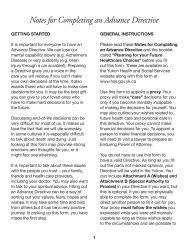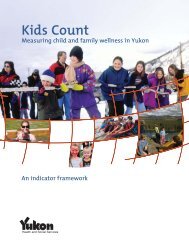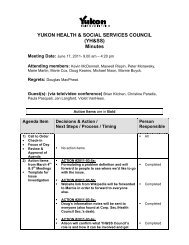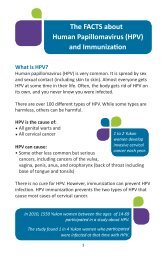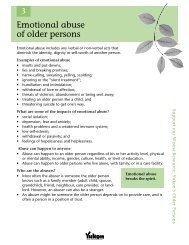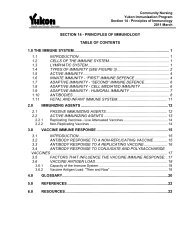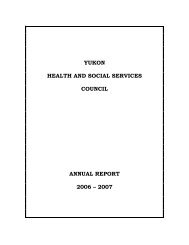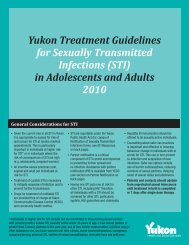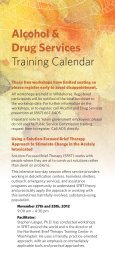EHS Guide for Human Health & Safety in Your Yukon Camp Facility
EHS Guide for Human Health & Safety in Your Yukon Camp Facility
EHS Guide for Human Health & Safety in Your Yukon Camp Facility
Create successful ePaper yourself
Turn your PDF publications into a flip-book with our unique Google optimized e-Paper software.
To help you get started here is some <strong>in</strong><strong>for</strong>mation on<br />
each of these subjects that you should know.<br />
► Dr<strong>in</strong>k<strong>in</strong>g Water<br />
Dr<strong>in</strong>k<strong>in</strong>g water <strong>in</strong> a camp can come from a variety of sources such as water delivery,<br />
bottled water, lakes, streams and wells.<br />
The most significant risks to human health from dr<strong>in</strong>k<strong>in</strong>g water come from<br />
microscopic organisms such as disease-caus<strong>in</strong>g bacteria, protozoa and viruses. The<br />
associated health effects can be quite severe and have long-term health impacts.<br />
Generally, sources such as deep-drilled wells, bottled water or municipal water are<br />
microbiologically safe whereas water drawn from shallow wells or surface water<br />
bodies such as lakes and streams is generally considered microbiologically unsafe.<br />
In <strong>Yukon</strong>, all water that is used <strong>for</strong> consumption, food preparation and hygiene must<br />
meet the quality outl<strong>in</strong>ed <strong>in</strong> the <strong>Guide</strong>l<strong>in</strong>es <strong>for</strong> Canadian Dr<strong>in</strong>k<strong>in</strong>g Water Quality. Water<br />
from shallow wells and surface sources requires treatment to make it safe.<br />
The <strong>Guide</strong>l<strong>in</strong>es <strong>for</strong> Canadian Dr<strong>in</strong>k<strong>in</strong>g Water Quality are developed by the Federal-<br />
Prov<strong>in</strong>cial-Territorial Committee on Dr<strong>in</strong>k<strong>in</strong>g Water and published by <strong>Health</strong> Canada.<br />
Understand<strong>in</strong>g them is vital to the health and safety of your camp.<br />
► Sewage Disposal<br />
Under the <strong>Yukon</strong> Public <strong>Health</strong> and <strong>Safety</strong> Act, the Sewage Disposal Systems<br />
Regulation applies to:<br />
“the disposal of sewage from all build<strong>in</strong>gs and like structures,<br />
temporary or permanent, vehicles which have toilet facilities and sewage<br />
produced from public gather<strong>in</strong>gs and campgrounds, except where<br />
disposed of by way of a municipal sewage system...”<br />
The sewage disposal system <strong>for</strong> your camp may <strong>in</strong>clude a pit privy, septic system,<br />
sewage hold<strong>in</strong>g tank, lagoons or package treatment plants. Improper sewage<br />
disposal systems can affect human health through exposure to disease-caus<strong>in</strong>g<br />
organisms and the attraction of <strong>in</strong>sects and wildlife. No matter what sewage disposal<br />
system you put <strong>in</strong> place, it must be designed, <strong>in</strong>stalled and operated <strong>in</strong> accordance<br />
with the Sewage Disposal Systems Regulation. Alternate designs must be<br />
approved by an Environmental <strong>Health</strong> Officer prior to <strong>in</strong>stallation.<br />
As it is highly unlikely that your camp facility will tie <strong>in</strong>to a municipal sewage disposal<br />
system, this regulation outl<strong>in</strong>es that your camp facility system must:<br />
— Be located so as not to contam<strong>in</strong>ate land, ground water or surface water.<br />
— Be set-back from build<strong>in</strong>gs, roads and property l<strong>in</strong>es so as not to pose a risk to<br />
human health.


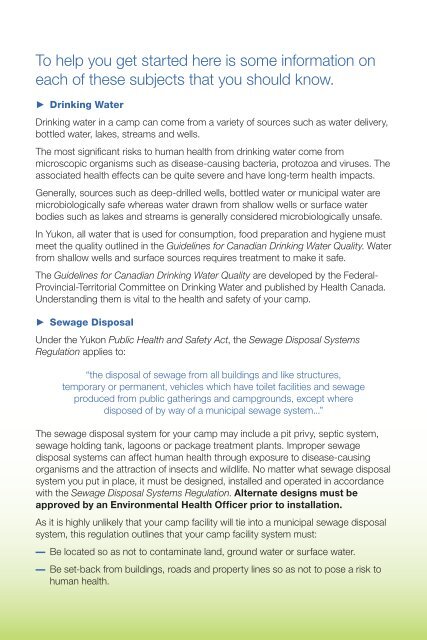
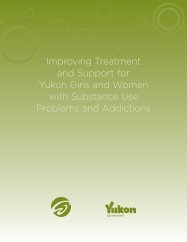
![Women and Alcohol: A women's health resource [2326.26 KB ]](https://img.yumpu.com/22340649/1/190x245/women-and-alcohol-a-womens-health-resource-232626-kb-.jpg?quality=85)
